Title: Nairobi to Moyale
Dates: 3rd to 11th July GPS:
Distance: 874km Total Distance: 18,960km
Roads: Hilly, tarmac to Archer’s Post; 400km of extremely rough and stony to Moyale
Weather: Cool at altitude, warm and dry in north Kenya
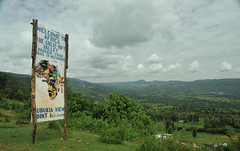 From Kigali to Nairobi the expedition had been congested with many project and game park visits and not so much cycling. Setting off from Nakuru however was the start of the final 4500km/six week phase. It was going to be intensive cycling pretty much to the finish – and a few project visits. The first three days of the challenge were very up and down, starting with a long tallying climb – across the Equator once more – to Nyahururu (2350m). Everything and anything grows in the Rift Valley soils. I cycled passed coffee, tea and sugar plantations. I then headed east towards Mt Kenya via Nanyuki and around Africa’s second highest mountain to Isiolo. I somehow managed to pick up another stomach bug and my system had to endure gastro No.4 for the journey. Out of Nanyuki I climbed again for about 40km to 2800m. Here there were large farms growing cereal crops such as barley and tunnels of fresh cut flowers, grape vines and other fruit. We were surprised to see barley growing so well at such an altitude.
From Kigali to Nairobi the expedition had been congested with many project and game park visits and not so much cycling. Setting off from Nakuru however was the start of the final 4500km/six week phase. It was going to be intensive cycling pretty much to the finish – and a few project visits. The first three days of the challenge were very up and down, starting with a long tallying climb – across the Equator once more – to Nyahururu (2350m). Everything and anything grows in the Rift Valley soils. I cycled passed coffee, tea and sugar plantations. I then headed east towards Mt Kenya via Nanyuki and around Africa’s second highest mountain to Isiolo. I somehow managed to pick up another stomach bug and my system had to endure gastro No.4 for the journey. Out of Nanyuki I climbed again for about 40km to 2800m. Here there were large farms growing cereal crops such as barley and tunnels of fresh cut flowers, grape vines and other fruit. We were surprised to see barley growing so well at such an altitude.
 Then came the best downhill of the journey so far – I dropped 1300m over the next 50km to enter Isiolo and a new world. We’d left behind the fertile highlands and entered a dry, dusty, rugged landscape with spectacular craggy ranges all round. The people were different too. Many more Muslims and mosques, many more nomads’ dwellings lining the road out of town, and much more begging than usual. Forty kilometres north of Isiolo, at Archer’s Post, we stayed with a group of Samburu people beside the river.
Then came the best downhill of the journey so far – I dropped 1300m over the next 50km to enter Isiolo and a new world. We’d left behind the fertile highlands and entered a dry, dusty, rugged landscape with spectacular craggy ranges all round. The people were different too. Many more Muslims and mosques, many more nomads’ dwellings lining the road out of town, and much more begging than usual. Forty kilometres north of Isiolo, at Archer’s Post, we stayed with a group of Samburu people beside the river.
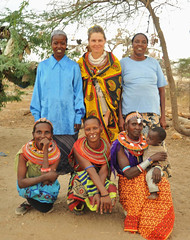 Samburu are nomadic herders with many customs similar to the Maasi and Turkana people. They wear brightly coloured clothes and plenty of jewellery, herd cattle, sheep and goats and live off a diet of milk mixed with blood and meat (no vegetables). Most of the women dress traditionally every day, not just for showing tourists.
Samburu are nomadic herders with many customs similar to the Maasi and Turkana people. They wear brightly coloured clothes and plenty of jewellery, herd cattle, sheep and goats and live off a diet of milk mixed with blood and meat (no vegetables). Most of the women dress traditionally every day, not just for showing tourists.
Like the Maasi we met, they are very proud of their cultures and traditions. The women had formed a group; the Meagari Early Childhood Group which seemed to be about ensuring their children’s education and future while empowering each other. The money we paid for camping beside their land and filming was divided amongst them. John also gave some pencils and notebooks which were gratefully received.
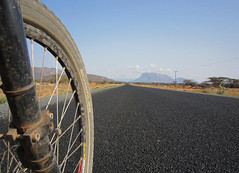 A young fellow named Robin took charge of organising us and explaining Samburu customs. He is part of the next generation – better educated and wanting to break away from the nomadic lifestyle. He explained that he has plans to build a guest house right beside the river. Now that the road has been paved, he says this is a great avenue for progress and he dreams of making a thriving business from passing travellers. Robin, his father and a couple of others kept watch over us all night beside a campfire, spear at the ready, to ensure our safety. Until recently, people had to travel in a convoy because of the threat of bandits. We’d heard about a motorcyclist who had had his spokes shot out a few months ago somewhere between Archer’s Post and Marsabit.
A young fellow named Robin took charge of organising us and explaining Samburu customs. He is part of the next generation – better educated and wanting to break away from the nomadic lifestyle. He explained that he has plans to build a guest house right beside the river. Now that the road has been paved, he says this is a great avenue for progress and he dreams of making a thriving business from passing travellers. Robin, his father and a couple of others kept watch over us all night beside a campfire, spear at the ready, to ensure our safety. Until recently, people had to travel in a convoy because of the threat of bandits. We’d heard about a motorcyclist who had had his spokes shot out a few months ago somewhere between Archer’s Post and Marsabit.
The great news for us was that Zdenek sent a message to say mission accomplished – he had the Ethiopian visas. What a relief that was for all of us. The whole episode had been absurd and expensive, but at least we had found a way. He was able to apply for and receive our visas in a day in Harare. Zdenek flew back to Nairobi and then took two buses to catch us in Laisamis the next night. We greeted him as a hero!
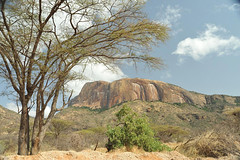 From Archer’s Post, I was fortunate to be able to coast along a further 65km of brand new tarmac. The scenery was superb with spectacular strips of ranges flanking the roadsides. There were many Samburu nomads milling around in the village at the end of the new tarmac.
From Archer’s Post, I was fortunate to be able to coast along a further 65km of brand new tarmac. The scenery was superb with spectacular strips of ranges flanking the roadsides. There were many Samburu nomads milling around in the village at the end of the new tarmac.
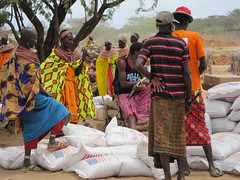 The World Food Program was distributing a monthly supply of food aid. This region was hit hard by drought last season and many of the nomads had lost all their animals – or at least most of them, which they rely on for their food and livelihood. This also explains why we had to endure so much begging out of Iliolo. The atmosphere was tense. People were on edge. Apparently 85% of the aid comes from the US, 5% from Japan and the rest from elsewhere, including Australia.
The World Food Program was distributing a monthly supply of food aid. This region was hit hard by drought last season and many of the nomads had lost all their animals – or at least most of them, which they rely on for their food and livelihood. This also explains why we had to endure so much begging out of Iliolo. The atmosphere was tense. People were on edge. Apparently 85% of the aid comes from the US, 5% from Japan and the rest from elsewhere, including Australia.
 I had a long discussion with one of the village leaders, Mark Rosket. He said that while the aid was much better than nothing, they need more than just maize. They need protein to sustain pregnant and lactating women and children. Maize is so different from their usual diet of blood, milk and meat. The chief explained that their priorities are: enough food to get them back on their feet, they need animals from which they can breed and get their herd numbers back up so they can maintain their normal life style and mostly they need to develop their education program.
I had a long discussion with one of the village leaders, Mark Rosket. He said that while the aid was much better than nothing, they need more than just maize. They need protein to sustain pregnant and lactating women and children. Maize is so different from their usual diet of blood, milk and meat. The chief explained that their priorities are: enough food to get them back on their feet, they need animals from which they can breed and get their herd numbers back up so they can maintain their normal life style and mostly they need to develop their education program.
As children are nomadic, it is difficult for them to receive education on the move and illiteracy is high. It is difficult to get teachers to embrace the lifestyle and travel with them. The chief said that education is the real priority as better educated people are more adaptable, have fewer healthier children and are better able to cope when they are faced with drought and other crises. There is a real problem with drunkardness in the community which contributes to the community problems.
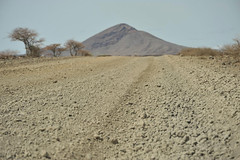 Reaching the boundary of Losai National Reserve also marked the end of any improved road. I had been expecting this shocking quality of road and feel fortunate that 100km of the 500km stretch is now good tarmac or gravel. It was a mixture of extremely deep corrugations and large loose stones. I could only average about 12 or 13km an hour on it and was shaken to bits. I did try trailblazing through the bush. There were some animal tracks and clay pans to follow, but overall it was no quicker. Even if it was more comfortable and interesting, the threat of punctures was high and it would only be a matter of time before pieces of the thorny bush penetrated my tyres. Eventually after landing in a thorn tree I decided to return to the main road.
Reaching the boundary of Losai National Reserve also marked the end of any improved road. I had been expecting this shocking quality of road and feel fortunate that 100km of the 500km stretch is now good tarmac or gravel. It was a mixture of extremely deep corrugations and large loose stones. I could only average about 12 or 13km an hour on it and was shaken to bits. I did try trailblazing through the bush. There were some animal tracks and clay pans to follow, but overall it was no quicker. Even if it was more comfortable and interesting, the threat of punctures was high and it would only be a matter of time before pieces of the thorny bush penetrated my tyres. Eventually after landing in a thorn tree I decided to return to the main road.
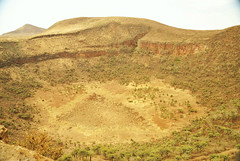 By the end of the day, chaffing was so bad I could barely touch the seat. I really struggled from Laisamis to Marsabit, the 100km took nearly eight hours! Marsabit is set on a volcanic mountain range, high above the plains I had been cycling over. In fact I had to climb almost a thousand metres over 50km to get there.
By the end of the day, chaffing was so bad I could barely touch the seat. I really struggled from Laisamis to Marsabit, the 100km took nearly eight hours! Marsabit is set on a volcanic mountain range, high above the plains I had been cycling over. In fact I had to climb almost a thousand metres over 50km to get there.
The next morning John contracted giardia and was feeling very ill. As soon as the pharmacist opened I bought the correct medication and John recovered very quickly. In fact he claimed it was the best dose of giardia he had ever had! In the past he had been sick for much longer. Zdenek and I spent the morning walking with local guide, Duba (dubakalicha@yahoo.com) to visit a huge, 600m-deep volcanic crater. On the way he also showed us graves from World War II when the British and Italians battled in the region.
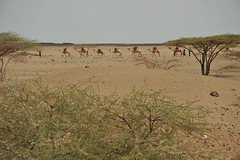 The shocking road continued as I descended out of the mountains to the stony Chalbi Desert. The region is almost totally barren and devoid of trees, apart from the odd thorn tree. The plains are covered with volcanic rubble and the road was probably the worst stony surface I have ever had to cycle. There were no alternatives beside the main road. I did try, but it was hopeless. The desert is the realm of the nomads and I came across large flocks of fatty tailed sheep being driven along the road. There were many camels too and the odd camel train. We saw ostriches and groups of gazelle nearer to Marsabit. Hundreds of tiny ‘dic dic’ deer closer to Moyale.
The shocking road continued as I descended out of the mountains to the stony Chalbi Desert. The region is almost totally barren and devoid of trees, apart from the odd thorn tree. The plains are covered with volcanic rubble and the road was probably the worst stony surface I have ever had to cycle. There were no alternatives beside the main road. I did try, but it was hopeless. The desert is the realm of the nomads and I came across large flocks of fatty tailed sheep being driven along the road. There were many camels too and the odd camel train. We saw ostriches and groups of gazelle nearer to Marsabit. Hundreds of tiny ‘dic dic’ deer closer to Moyale.
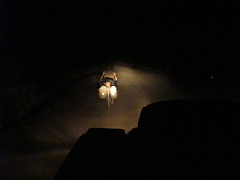 The final day into Moyale at the Ethiopian border was massive – 10 hours for 145km. The road did improve from the horrific loose stone surface, but was still very heavy going and rough much of the time. The last hour was done in complete darkness with just the headlights to guide the way. It was probably fortunate I couldn’t see what was coming for the finale – a 700metre climb in the dark! I was knackered, but it was good to get to Moyale to watch the World Cup Final.
The final day into Moyale at the Ethiopian border was massive – 10 hours for 145km. The road did improve from the horrific loose stone surface, but was still very heavy going and rough much of the time. The last hour was done in complete darkness with just the headlights to guide the way. It was probably fortunate I couldn’t see what was coming for the finale – a 700metre climb in the dark! I was knackered, but it was good to get to Moyale to watch the World Cup Final.
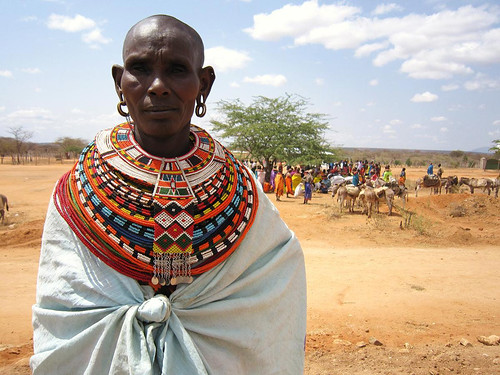



{ 1 comment… read it below or add one }
time for another update Kate! You must be very near the finish line now, a fantastic achievement